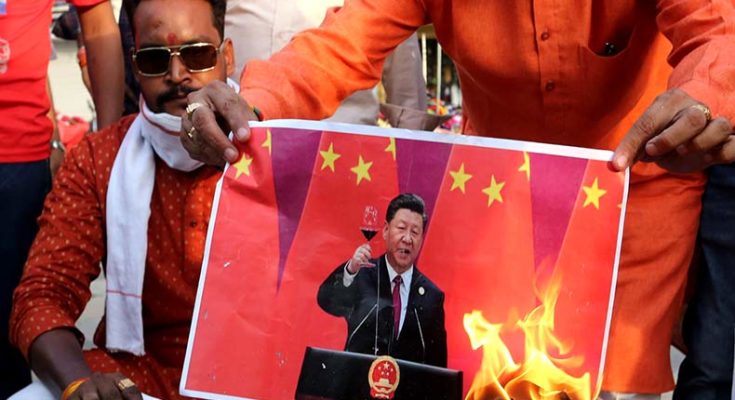Is it possible for India to boycott all the Chinese products suddenly? Image Courtesy – The Guardian
Nowadays, the people of India are boiling with an anti-China wave, the leaders and supporters of BJP also are trying to blow-up the ‘Swadeshi’ wave throughout India. Some of the BJP leaders are threatening in front of media channels that they will break the legs of the users who will use China products. But, are they really aware of the condition of the Indian economy? If they are not, then they are simply blowing up the ‘Swadeshi’ campaign only as an election gimmick.
Boycotting Chinese products in a day – is that so easy? Let us analyze some aspects:
India-China Trade volume statistics
In the financial year 2018-2019, India has made business with China of around $87.07 billion. There has been US$70.32 billion of import from China in the year 2018-2019. On the other hand, the export from India to China was just US$ 16.75 billion. It defines that the trade deficit of India was 8% in that financial year.
Why Chinese products have captured the Indian market?
The simple reason for a Chinese product to capture the Indian market is of low price. Indian manufacturers are unable to deliver their products at such a low price.
Production cost in China is low due to the availability of cheap labour, and automatically the cost of a product becomes cheap.
Another reason for the low-cost production is that the government of China provides a subsidy to the manufacturing units in their country.
A huge quantity of product is produced in China. That is one of the reasons for the low price of Chinese products.
On the other hand, the production cost of Indian manufacturers is higher due to costly raw material, application of old technology, higher fixed cost etc. The Indian products are unable to compete with the Chinese products due to higher cost of production and Indian products are unable to compete at the international level too.
Read: Will India get any benefit in the world economy after the epidemic?
Chinese products that are imported in India
India usually imports electronics products, parts of computers, toys, lightings, cars and motorcycles, car parts, milk products, fertilizers, antibiotics, smartphones etc.
Indian products that are exported to China
The products that India exports to China are like agricultural products, cotton textiles, handicrafts, raw lead, iron ore, steel, copper, telecom content etc. The quantity of diamond that India exports to China is around 36% of the total exports.
Which production sector in India is the most affected by China?
The toy industry of India is heavily affected by cheap Chinese products. The cost of Chinese toys is so cheap that no Indian company is yet to compete with Chinese products. In the financial year 2018-2019, only 20% of the Indian manufactured toy products captured the Indian market, the rest of the 80% was captured by the Chinese and Italian products.
Just for an example of the smartphone industry, here we see a Chinese smartphone comes with a reasonable price and with a huge list of features and incorporated with new technology. But, in comparison to the product, if we search for an Indian company for a similar type of product with similar features and technology, we will get nothing. So, it is clear that there is a huge gap in development and production between China and India in terms of quality and quantity of products.
The Associated Chambers of Commerce and Industry of India released a report that shows 40% of the toy manufacturing companies in India have been closed in the last 5 years and 20% of them are in a way to shut down due to loss incurred in the business.
China has broken the capacity of the production industry in India by exporting cheap electronic products. The Chinese vendors have increased their grip in the Indian smartphone market significantly from 2017. They captured a 51.4% share in the area of smartphone shipments in India and 16.9% incidental growth in India. In the last year, the Chinese vendors gained a 142.6% growth in their business.
Read: Worst financial crisis to come since 1930
How much India is dependent on China
India’s export to China was $3,833 million in the financial year 2015-2016, which was only 3.59% of the total exports of India. Similarly, India’s import from China was $25,460 million in the financial year 2015-2016, which was 15% of the total imports of India. The share of China in India’s total import was 11.76% in the financial year 2010-2011. It increased by 15% in the financial year 2015-2016.
The leaders of the ruling government in the centre should analyze the critical situation of the Indian manufacturing units and the feasibility of a self-reliant India in a short period of time.
Results of banning Chinese products in India
The Indian market is a price-sensitive market. A company has to keep its product price low to grab the market because Indian consumers are generally concerned about the price of a product. Indian products are much costlier in comparison to Chinese products. The people belonging to the ‘low-income group’ will suffer a lot because they are unable to purchase Indian products which are costlier than Chinese products. Still, no such alternatives have been developed in the Indian manufacturing sector. There may be a rise in the inflation rate in India after banning all Chinese products.
Hence the Government of India needs to make a wise decision without being biased by the emotion of the people on this matter. But, some of the necessary steps the government of India can take in this regard. They can impose an ‘anti-dumping duty’ and ‘countervailing duty’ on the low price Chinese products like electronic items, toys etc. Imposing the two duties will force the price of Chinese products to increase in the Indian market.
Now, Indian manufactures need to take the chance to manufacture those products on Indian soil. By doing this, the cost of production will decrease and new employments will be generated. The more production increases, the more price will be dropped in comparison to the Chinese products in the new situation. The government should also provide subsidy to the manufacturing sectors to promote India into a self-reliant country.
Reference: The Guardian, Jagran Josh





